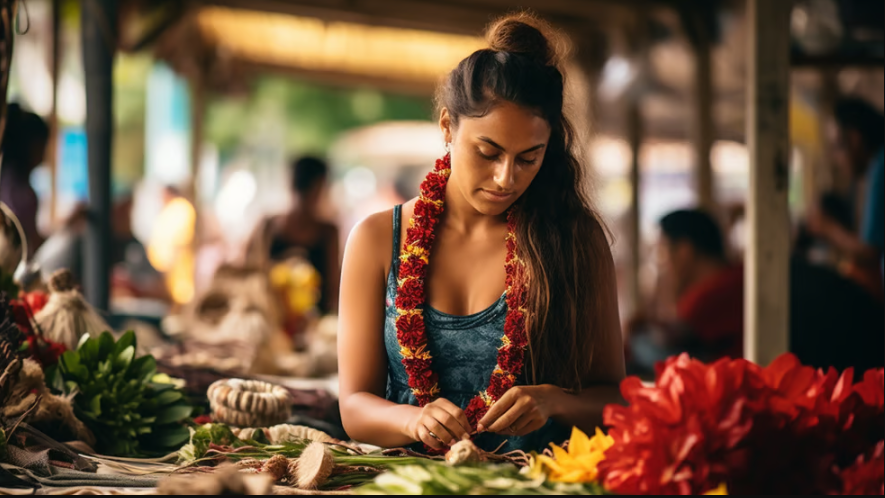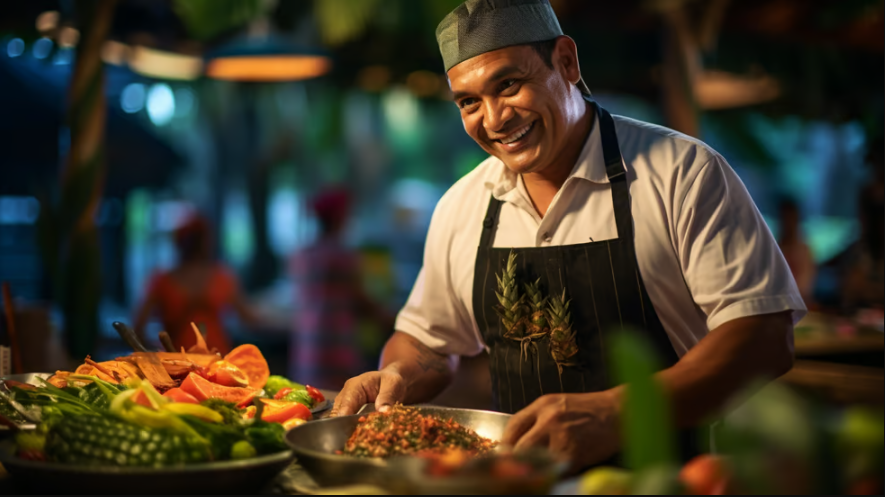Tahiti Beyond the Honeymoon: A Cultural Dive
Explore the soul of Tahiti, where vibrant culture pulses through the island's veins, offering a rich tapestry of experiences far beyond the idyllic honeymoon bungalows.



Tahiti, a paradise often associated with romantic honeymoons and idyllic beaches, is a destination that offers much more than meets the eye. Beyond the dazzling sunsets and crystal-clear waters lies a vibrant culture, rich with history, art, cuisine, and natural wonders. In this article, we will dive deep into the heart of Tahiti, exploring its captivating cultural heritage and uncovering the hidden gems that make this island truly unique.
Unveiling the Real Tahiti
When we think of Tahiti, we envision a tropical paradise, but there is so much more to this enchanting destination. Digging into the history of Tahiti reveals a fascinating past influenced by Polynesian, European, and Asian cultures. The island's indigenous people, known as the Ma'ohi, have inhabited Tahiti for over 1,000 years, and their cultural traditions remain an integral part of daily life.
As we delve deeper into the captivating history of Tahiti, we discover the remarkable stories of the first Polynesian settlers who arrived on these shores. These brave explorers navigated the vast Pacific Ocean, guided only by the stars and their ancient knowledge of celestial navigation. Their arrival marked the beginning of a new era for Tahiti, as they established a thriving society that would shape the island's identity for centuries to come.
The History of Tahiti
Tahiti has a rich and complex history. From the arrival of the first Polynesian settlers to the impact of European explorers, including Captain James Cook, who discovered the island in 1767, Tahiti has seen a myriad of influences throughout the centuries. Exploring the remnants of ancient sacred sites and learning about the significance of marae, traditional meeting places, provides a glimpse into Tahiti's past.
One cannot fully comprehend the history of Tahiti without acknowledging the profound impact of European explorers. Captain James Cook's arrival on the island in the late 18th century marked a turning point in Tahitian history. His interactions with the locals and subsequent reports of the island's beauty and abundance sparked a wave of European interest in Tahiti, leading to increased trade and cultural exchange.
The Tahitian Language and its Significance
The Tahitian language, te reo Ma'ohi, is an important aspect of Tahitian culture. While French is the official language, the locals take pride in preserving their ancestral language. Learning a few basic Tahitian phrases not only helps navigate the island but also fosters a deeper connection with the local community, who appreciate visitors making an effort to embrace their language and customs.
Immersing oneself in the Tahitian language opens up a world of understanding and appreciation for the island's rich cultural heritage. The melodic tones and unique vocabulary of te reo Ma'ohi reflect the deep connection between the Tahitian people and their natural surroundings. From the names of plants and animals to traditional chants and songs, the Tahitian language is a gateway to unlocking the secrets of this captivating paradise.
Tahitian Traditional Customs
Tahitian customs are deeply embedded in everyday life, and experiencing these traditions firsthand is a highlight of any visit to the island. From the wearing of flower crowns, or hei, to the practice of haere mai, the warm and welcoming spirit of Tahiti can be felt at every turn. Witnessing a traditional farewell ceremony, known as the 'ahu' or 'au revoir', provides a glimpse into the heartfelt bond that exists within Tahitian communities.
One cannot help but be captivated by the vibrant customs and rituals that define Tahitian culture. The art of crafting intricate flower crowns, known as hei, is a cherished tradition passed down through generations. These fragrant adornments not only add a touch of natural beauty to the wearer but also symbolize love, respect, and connection to the land.
Another fascinating aspect of Tahitian customs is the practice of haere mai, which translates to "come here" in English. This warm greeting reflects the genuine hospitality and inclusivity of the Tahitian people. Whether it's a simple smile, a friendly wave, or an invitation to share a meal, the spirit of haere mai embodies the essence of Tahiti's welcoming culture.
there are few places as remarkable as the South Pacific. With its clear skies, pristine beaches, and diverse cultures, this region provides an ideal setting for exploring the wonders of the night sky.
The Richness of Tahitian Cuisine
One cannot truly experience Tahiti without indulging in its exquisite cuisine. Tahitian dishes combine traditional Polynesian flavors with French and Asian influences, resulting in a unique culinary experience that tantalizes the taste buds.
Tahiti, the largest island in French Polynesia, is a paradise not only for its stunning beaches and crystal-clear waters but also for its rich and diverse food culture. The fusion of flavors, techniques, and ingredients in Tahitian cuisine reflects the island's history and cultural heritage.
Popular Tahitian Dishes
Poisson cru, a mouth-watering dish consisting of raw fish marinated in lime juice and coconut milk, is a must-try for seafood lovers. The combination of tangy lime, creamy coconut, and fresh fish creates a burst of flavors that perfectly captures the essence of Tahiti.
Another delicacy is fafa, cooked taro leaves with coconut milk and pork, providing a true taste of Tahitian comfort food. The tender taro leaves, cooked to perfection with succulent pork and creamy coconut milk, create a hearty and satisfying dish that warms the soul.
Don't forget to sample Tahiti's famous dishes, such as po'e, a delicious dessert made from mashed bananas and arrowroot. This sweet treat, often served with a drizzle of coconut cream, is a delightful way to end a meal and satisfy your sweet tooth.
Unique Ingredients in Tahitian Cooking
What sets Tahitian cuisine apart are its unique ingredients sourced from the island's bountiful landscapes. Taro, a starchy root vegetable, is a staple in Tahitian cooking and is used in various dishes, from savory to sweet. Its versatility and earthy flavor add depth to Tahitian cuisine.
Breadfruit, another essential ingredient, is often roasted, baked, or boiled and served as a side dish or incorporated into main courses. Its mild taste and starchy texture make it a perfect complement to the bold flavors found in Tahitian cuisine.
Coconuts, abundant in Tahiti, are not only used for their refreshing water but also for their versatile meat and milk. Coconut milk adds a rich and creamy element to many Tahitian dishes, while freshly grated coconut adds texture and a touch of sweetness.
The Role of Food in Tahitian Culture
Food is more than sustenance in Tahitian culture; it is a way of connecting with others and forming lasting bonds. Sharing a meal with locals is an opportunity to immerse oneself in the vibrant and warm-hearted nature of Tahitian hospitality.
From lively food markets to traditional feasts known as "aha'ai," the importance of food extends beyond the dining table, bringing people together and fostering a sense of community. These gatherings are filled with laughter, music, and the aroma of delicious dishes being prepared with love and care.
Moreover, the preparation of food in Tahitian culture is considered an art form. Traditional cooking methods, such as using an underground oven called "ahima'a" to slow-cook meat and vegetables, highlight the islanders' deep connection with their ancestral roots and their respect for the land.
As you explore the flavors of Tahitian cuisine, you will not only satisfy your taste buds but also gain a deeper understanding of the island's history, culture, and the people who call it home. So, indulge in the richness of Tahitian cuisine and let the flavors transport you to this tropical paradise.
The Vibrancy of Tahitian Art and Music
Art and music play a significant role in Tahitian society, serving as a means of cultural expression and preserving traditions passed down through generations.
Tahiti, a tropical paradise in the South Pacific, is known for its vibrant art and music scene. The island's rich cultural heritage is beautifully captured in the intricate designs of Tahitian tattoos and the rhythmic beats of traditional music. Let's delve deeper into the fascinating world of Tahitian art and music.
Understanding Tahitian Tattoos
Tahitian tattoos, or tatau, hold a special place in Polynesian culture. Each design carries meaning and symbolism, representing one's heritage, lineage, and personal experiences. The art of tattooing in Tahiti is an ancient practice that dates back centuries. It is believed that tattoos were not only a form of self-expression but also served as a spiritual connection to the gods.
When getting a traditional Tahitian tattoo, the process is not just about the final design but also about the journey. The tattoo artist, known as a tufuga ta tatau, carefully selects symbols and patterns that reflect the individual's story. The process itself is a sacred ritual, with the artist using traditional tools made from bone, wood, and turtle shell to create the tattoo.
Learning about the art of tattooing in Tahiti provides insight into the spiritual and cultural significance of this ancient practice. It is a testament to the resilience and pride of the Tahitian people, who have preserved their traditions despite the influences of modernization.
The Sounds of Tahiti: Traditional Music
Traditional Tahitian music, pulsating with the rhythmic beats of drums and the melodies of flutes, transports listeners to another world. The music of Tahiti is deeply rooted in the island's history and legends, serving as a way to pass down stories from one generation to the next.
Attending a traditional dance performance, known as an "ori Tahiti," is an unforgettable experience that allows visitors to immerse themselves in the captivating rhythms of the islands. The dancers, adorned in vibrant costumes made from natural materials like feathers and shells, move gracefully to the music, their bodies swaying in perfect harmony.
Through dance and music, the rich history, legends, and stories of Tahiti are brought to life. Each movement has a purpose, conveying emotions and narratives that have been passed down through generations. It is a celebration of the island's vibrant culture and a testament to the talent and dedication of the dancers and musicians.
The Colorful World of Tahitian Dance
Dance is at the heart of Tahitian culture, and it is impossible to resist the infectious energy and grace of Tahitian dancers. The fast-paced movements, vibrant costumes, and intricate choreography tell tales of love, nature, and triumph.
Taking a Tahitian dance class is an opportunity to learn the artistry behind the hips swaying to the rhythm of the drums. The dance instructors, often experienced performers themselves, teach students the basic steps and techniques that make Tahitian dance so unique. From the graceful hand movements to the powerful hip rotations, every aspect of the dance is carefully crafted to convey the spirit and essence of Tahiti.
As you immerse yourself in the world of Tahitian dance, you will discover the deeper meaning behind each movement. The dances often depict stories from Tahitian mythology, showcasing the island's connection to nature and its reverence for the gods. It is a mesmerizing experience that allows you to connect with the soul of Tahiti and understand the cultural significance of dance in this vibrant society.

Exploring Tahiti's Natural Wonders
While the cultural aspects of Tahiti are captivating, the island's natural beauty is equally awe-inspiring. From pristine beaches to lush rainforests, Tahiti offers a paradise for nature enthusiasts.
The Importance of the Ocean in Tahitian Culture
The ocean holds a deep spiritual connection within Tahitian culture. It not only sustains the islanders with its abundant seafood, but it also serves as a source of inspiration and reverence. Engaging in water activities such as snorkeling, paddleboarding, or simply taking a dip in the azure waters allows visitors to immerse themselves in the ocean's embrace.
Tahiti's Unique Flora and Fauna
Tahiti is home to an incredible array of plant and animal species, many of which are endemic to the island. Embarking on a hike through the island's lush rainforests reveals a world of vibrant flowers, towering trees, and exotic wildlife. Exploring the unique ecosystems of Tahiti provides a deeper appreciation for the island's fragile biodiversity.
The Beauty of Tahiti's Landscapes
Tahiti's landscapes are a photographer's dream, with dramatic mountain peaks, turquoise lagoons, and cascading waterfalls creating postcard-perfect scenes. From the rugged beauty of Marina Taina to the enchanting allure of the Three Waterfalls of Faarumai, the natural wonders of Tahiti never fail to leave a lasting impression.
As you can see, Tahiti offers a world beyond the honeymoon clichés. It is a place where ancient traditions thrive, art and music resound, and natural wonders beg to be explored. Whether you are seeking a cultural immersion or an adventure amidst breathtaking landscapes, Tahiti promises to captivate your senses and leave an indelible mark on your soul. So, pack your bags, delve into Tahiti's vibrant culture, and embark on a journey that will forever enrich your travel experiences.